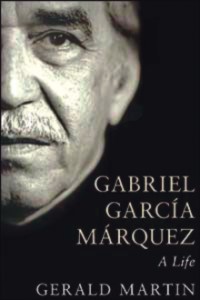| Book Review
A Quixotic World
STEPHEN SMITH
 |
Gabriel García Márquez: A Life by Gerald Martin |
Forget magical realism - an exhaustive life of Gabriel García Márquez reveals him as a much worldlier writer than that. Graham Greene, many of whose best books were set in Latin America, was baffled by critics who 'referred to a strange, violent, seedy region of the mind which they called Greeneland'. The novelist, who had witnessed wars, revolutions and many varieties of depredation, said: 'I have sometimes wondered if they go round the world blinkered.' While Greene was accused of making things out to be worse than they were, Gabriel García Márquez has suffered from the opposite problem. He has never been given the credit for the penetrating candour of his work. He should worry, you might say.
The Colombian novelist is everybody's favourite writer of magical realism, that warm and fuzzy genre burdened with overtones of whimsy and parlour tricks. He's been compared to Cervantes, perhaps his only rival as the outstanding writer of the hispanic world. His novels have brought him the Nobel prize and fame and riches beyond the dreams of a telegraphist's son from a dirt-poor town. But the publication of Gerald Martin's official biography is a welcome opportunity to foreground the worldliness of his writing, its head-clearing skankiness. It's the neglected element in what John Updike calls 'the curious blend of the enchanted and the squalid' in his work.
Like Greene, García Márquez wants to tell us: 'This is how it is.' Indeed, as Martin points out, 'he has always asserted that far from being a "magical realist", he is just a "poor notary" who copies down what is placed on his desk'. It's true that his stories are exuberantly folkloric and take liberties with time. But any idea that they are out of touch with reality fails to survive contact with the extraordinariness of Colombian life. Or with his own life, come to that, as it emerges from the punctilious minutes of Martin's account. (If García Márquez is apt to play fast and loose with chronology, his admiring biographer, by contrast, has the scrapbook-filling exhaustiveness of the stage mother.)
Is there anything in his supposedly outlandish canon to overshadow the genuine exploits of Colombian drug barons, who stocked their ranches with flamingoes and hippos airlifted from Africa? Even the great 'Gabo', as García Márquez is know back home, might struggle to imagine a more unlikely scene than the one I witnessed in Medellín last year, when the millionaire Colombian artist Fernando Botero, now in his seventies, accepted the plaudits of his hometown crowd in the local bullring, with several hundredweight of snorting livestock pawing the dirt only a few yards away from him.

As much as anything, García Márquez's life story is a reminder of the lurid horror and violence of his native land, what we might call its 'tragic realism'. In the first few pages we learn about 'Dead Man's House', the property of a neighbour of the García Márquez family 'who went on living there after hanging himself and could clearly be heard coughing and whistling inside'. On the day Gabo's baby brother was christened, 'a local trumpeter had his throat slit at the very moment he was straining to blow the highest, wildest note'. And then there was the terrible massacre of striking banana workers in 1928, the defining moment of García Márquez's childhood, if not his entire life, and the real-life antecedent of the events narrated in One Hundred Years of Solitude, the book that made his name. Against this highly-coloured backdrop, his novels begin to look like models of diffidence and stylistic frugality.
Like Greene, and Hemingway, an early hero, García Márquez the novelist was also a journalist: one with the double-edged distinction of turning up at the wrong place at the right time. He was in the capital of Colombia, Bogotá, in 1948 when a presidential candidate, Jorge Eliécer Gaitán, was assassinated, precipitating the more or less unbroken civil strife that the country has endured ever since. To the chagrin of the then struggling wordsmith, his typewriter was carried off by a mob that looted a pawnshop where it was in hock. A young Cuban ideologue called Fidel Castro was on the streets of Bogotá that day. In time, García Márquez became a privileged scribe at the court of President Castro - the confidante of the 'Maximum Leader' and the poet laureate of his legend. His non-fiction stands comparison with his novels, and readers who fear that candy-coated magical realism will strip their enamel are directed to News of a Kidnapping, a never-bettered study of one of Colombia's staple earners of hard currency.
On completing one of his books, García Márquez said he didn't know whether he had a masterpiece on his hands or a kilo of paper. Martin's commodious record certainly puts the life of García Márquez down in black and white, though the man himself remains something of an enigma even after almost 600 pages. He is now in his eighties, and Martin alludes delicately to failing health. Inevitably, in its latter stages, the book becomes a chronicle of a death foretold. Indeed, Martin reveals that he had spent 17 years studying García Márquez, and had written more than 2,000 pages about him, with 6,000 footnotes, when it dawned on him that Gabo might die before he could read it. Not only that: 'I realised that perhaps I would never finish the project.' It's a story worthy of García Márquez, the heir to Cervantes, that his dogged biographer should find himself grappling with such a quixotic task.
Copyright
(R) thedailystar.net 2010 |
|
